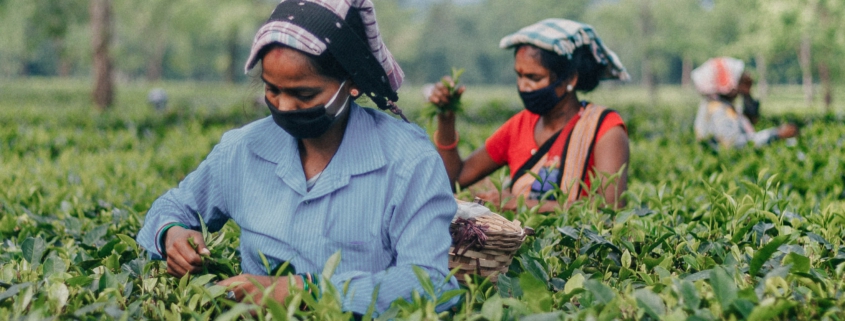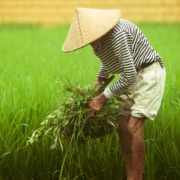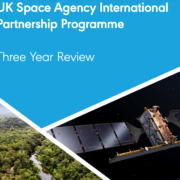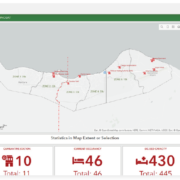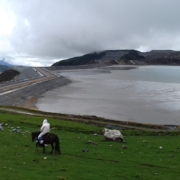UK Space Agency IPP’s Agri-Webinar
The UK Space Agency’s International Partnership Programme (IPP) hosted an online workshop on Thursday 29th October for the agricultural projects in IPP. Eleven projects attended, represented by ~35 attendees. The objective of the session was to provide a forum for networking and sharing of knowledge and lessons between the IPP projects, with the work undertaken to support the sustainability of impacts generated over the longer term.
After a welcome from Athene Gadsby, the UK Space Agency’s IPP Programme Manager, each consortium provided a three-minute lightning introduction overviewing their project in terms of the objectives, partners and results so far. This session highlighted the diversity of the project portfolio and the breadth of technologies, impact objectives and geographical focus within it.
A guest speaker, Eli Pollak (CEO of Apollo Agriculture) joined to provide an external perspective on the use of earth observation in agriculture. Apollo Agriculture is a technology company based in Nairobi, Kenya. It helps small-scale farmers maximise their profits by using satellite data, machine learning, and automated operations to enable better credit decisions and keep costs low and processes scalable. Eli provided an overview of their business model of providing an optimised bundle of products e.g. fertiliser and seed, information products e.g. agronomic advice, and financing e.g. loans, to service the full suite of needs of small-scale farmers. From a technical perspective, Eli explained how the company uses satellite imagery and machine learning to help assess the credit worthiness of each farmer. He also highlighted the importance of ensuring that the farmers are aware of how their personal data and information is being used, and how they benefit in terms of service quality and price, etc.
During the afternoon session, we ran a set of virtual breakouts focused on a variety of topics on achieving and measuring impact, and how to ensure the long term financial sustainability of the service delivered via the project and hence ensure the long term sustainability of the impacts that the project was set up to achieve. A brief summary of each breakout room is below:
How to quantify agricultural impacts – beyond the metric of yield?
This group acknowledged that whilst improvements in yield is commonly an impact indicator for agricultural projects, due in part to its direct link to the SDGs, there are broad benefits that the yield indicator doesn’t capture. This might include increased efficiency and use of agricultural inputs, better management of production to smooth out volumes, reduced environmental damage, improved crop quality and mitigation of potential loss through extreme weather events, disease or pests. Our discussions suggested that alternative measurements including improved resilience and the ability to foresee events in order to take action were important for many projects.
What are the common pitfalls to measuring agricultural impacts, such as the timing of harvest cycles, getting buy-in from farmers to actually make changes, and defining counterfactuals?
Timing was the most common issue raised by this group. It was noted that whilst an IPP project, and the development of the product, might take 4-5 years, many agricultural impacts take many more years to emerge. At the same time, aligning harvest cycles to product development and the rhythm of reporting and evaluation within IPP creates a challenge for data collection and impact measurement in agricultural projects. Many projects also shared concerns related to attribution, and how to measure the effect of their specific agronomic advice on a complex farming system. For example, it is difficult to fully account for the action taken by farmers to act on agronomic recommendations, and how it creates an impact when faced with multiple, external, complex factors that might also influence the result. Participants noted that using counterfactuals and control groups to assess this issue of attribution might be technically possible, but also raised ethical considerations relating to the exclusion of certain growers from these interventions. Participants suggested that as an alternative to control groups, national level data could be used to understand general trends.
What value is the user going to derive from the solution, does that outweigh the costs, and who pays?
This group noted that achieving post grant financial sustainability can be difficult and very time consuming requiring a lot more effort than originally expected in terms of meetings, demonstrations and negotiations with potential customers/funders. It was discussed how it is difficult for smallholders to pay directly for the services, but not impossible as demonstrated by Apollo Agriculture, whereas perhaps larger agri-business was a more viable customer. Some IPP projects are pursuing a ‘top down’ approach by providing their services directly to government customers, e.g. Ministries of Agriculture, while other projects are looking from the ‘demand’ side, e.g. with the cooperatives and wholesalers that aggregate smallholder supply and seeing how they can expand the service to others in the value chain to add other benefits over productivity. Automation may be another way to drive down costs and make the services more affordable, but that could be more difficult in developing countries as it will take a long time and investment.
What is the role of EO in the agricultural sector in regards to insurance and credit?
Many of the agricultural projects in IPP are investigating whether EO can be used to improve the provision of insurance to farmers. We heard from Airbus their plans to improve the offering of flood & drought insurance for farmers in Kenya, eOsphere’s efforts in Mongolia to support an index based insurance scheme for herders, and Rezatec in Mexico aiming to improve insurance products for wheat and sugarcane farmers. Victoria Clause (Technology and Agriculture Consultant, Mercy Corps AgriFin) provided an opinion on how bundling both credit and insurance products has led previously to greater demand from smallholder farmers. Finally, Assimila highlighted that whilst it is possible to create index based insurance for some hazards e.g. rainfall for drought, others such as pest risk are harder to identify an appropriate index.
We will be hosting further workshops in spring 2021 to build on this knowledge-sharing event. If you have specific ideas for such an event, please do contact Caribou Space on nicki@cariboudigital.net.
